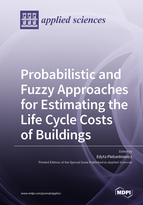Probabilistic and Fuzzy Approaches for Estimating the Life Cycle Costs of Buildings
A special issue of Applied Sciences (ISSN 2076-3417). This special issue belongs to the section "Civil Engineering".
Deadline for manuscript submissions: closed (20 August 2021) | Viewed by 25144
Special Issue Editor
Interests: tendering and bidding; planning methods in construction projects; building life cycle cost; fuzzy logic; construction management
Special Issues, Collections and Topics in MDPI journals
Special Issue Information
Dear Colleagues,
It is my pleasure to announce the opening of a new Special Issue in the Applied Science Journal.
The main topics of this Special Issue will be regarding approaches for estimating the life cycle cost of buildings. The construction sector is a major consumer of natural resources and cost. Life cycle cost (LCC) makes it possible for the whole life performance of buildings and other structures to be optimized. The introduction of the idea of thinking in terms of a building life cycle resulted in the need to use appropriate tools and techniques for assessing and analyzing costs throughout the life cycle of the building. Traditionally, estimates of LCC have been done based on historical analysis of data and have used deterministic models. The concepts of probability theory can also be applied to life cycle costing, treating the costs, and timings as a stochastic process. If any subjectivity is introduced to the estimates, then the uncertainty cannot be handled using the probability theory alone. The fuzzy sets theory is a valuable tool for handling such uncertainties. Possible improvements to the traditional approach models, using, for example, an analytical hierarchical model (AHP), are proposed.
From this perspective, this Special Issue will contribute to the field by presenting the most relevant advances in this research area.
The following are some of the topics proposed for this Special Issue (but not limited to):
- Methods and technics of LCC analysis
- Probabilistic and fuzzy approaches for estimating the Life Cycle Cost of building systems and components
- Probabilistic and fuzzy approaches for estimating the cost at different stages of a building's life cycle
- The factors affecting the LCC of building
- Determining the data required for the LCC calculation
- Dealing with uncertainty in LCC analysis
- Software for LCC analysis of buildings and building systems
- Using the BIM tool in the building cost calculation
We hope you will contribute your high-quality research and we look forward to reading your valuable results.
Prof. Dr. Edyta Plebankiewicz
Guest Editor
Manuscript Submission Information
Manuscripts should be submitted online at www.mdpi.com by registering and logging in to this website. Once you are registered, click here to go to the submission form. Manuscripts can be submitted until the deadline. All submissions that pass pre-check are peer-reviewed. Accepted papers will be published continuously in the journal (as soon as accepted) and will be listed together on the special issue website. Research articles, review articles as well as short communications are invited. For planned papers, a title and short abstract (about 100 words) can be sent to the Editorial Office for announcement on this website.
Submitted manuscripts should not have been published previously, nor be under consideration for publication elsewhere (except conference proceedings papers). All manuscripts are thoroughly refereed through a single-blind peer-review process. A guide for authors and other relevant information for submission of manuscripts is available on the Instructions for Authors page. Applied Sciences is an international peer-reviewed open access semimonthly journal published by MDPI.
Please visit the Instructions for Authors page before submitting a manuscript. The Article Processing Charge (APC) for publication in this open access journal is 2400 CHF (Swiss Francs). Submitted papers should be well formatted and use good English. Authors may use MDPI's English editing service prior to publication or during author revisions.
Keywords
- Life cycle cost (LCC)
- Whole life costing (WLC)
- Fuzzy approach
- Decision-making
- Cost modeling
- Building
- Construction
- Cost calculation
- Building information modeling (BIM)






